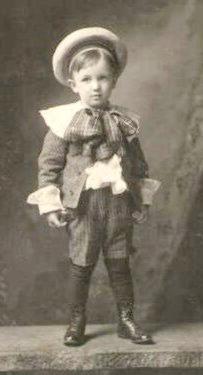
Figure 1.--This American boy in a 1890s photo wears a Fauntleroy suit made out of a patterened material.


Figure 1.--This American boy in a 1890s photo wears a Fauntleroy suit made out of a patterened material. |
Fauntleroy suits were primarily velvet suits. Some fancy suits
were made of satin, but these were much less common than the velvet
suits. The better suits were usually lined
with silk and worn with lace and ruffle trimed cambric blouses. Other less expensive suits were
made for mothers of more modest means from serge, flannel, and a variety
of other cloths. Most of these materials are solid colors, but Fauntleroy
suits were also made of patterned material. Many of the patterned fabrics
appear to be lighter weight materials for summer wear.
Fauntleroy outfits were suits, meaning the jacket and kneepants were
made of the same material.
There was one exception to the general pattern of Fauntleroy suits.
The primary exception to this could be the Fauntleroy kilt
in which a standard Fauntleroy jacket was worn with a kilt. There were
two basic types of the Fauntleroy kilt.
Suit kilts: Some Fauntleroy kilts were made just like regular
Fauntleroy suits with the kilt made of the same material, usually
velvet, as the jacket.
Scottish plaid: Other Fauntleroy kilts were made with a
Scottish plaid. Unlike the kilt suits of the day, the Fauntleroy was often a bright red kilt to
contrast with the dark jacket. While some kilts were made in the suit style,
with a material matching the jacket, the outfits with a Scottish plaid were more popular.
Most Fauntleroy suits were made of velvet. This was especially true of
the expensive suits made for wealthy families. The
velvet of the day
was an expensive fabric made from silk.

Figure 2.--The classic Fauntleroy suit was made of black or a dark colored velvet as worn by these brothers. Note the classic small jacket to show off the fance blouse. |
Another expesive material used in Fauntleroy suits were
satin. These suits were even more
expensive than velvet. They were not commonly worn. Wealthy parents
who wanted to dress their sons up for a special occasion, however,
might choose a satin suit.
There were some exceptions to the usual use of velvet in Fauntleroy
suit.
Summer: Velvet was a relatively heavy fabric. A velvet Fauntleroy
suit could be quite warm during the summer. Thus some suits were made with lighter-weight
fabric that would be more comfortable. Many of these suits were also
expensive, although the fabric was not usually as expensive as velvet.
Lower price: Some parents of modest means also wanted to dress their sons in the
popular Little Lord Fauntleroy fashion, but could not afford expensive
velvet suits. These less expensive suits were
made for mothers of more modest means from serge, flannel, and a variety
of other cloths.
One HBC contributor questions if the less ornate suits made from cheap
material deserve to be called 'Fauntleroy suits,' as referred to on this
page. Opinions might vary amongst fashion historians as to what exactly
constituted a Fauntleroy suit. The contributor would prefer to reserve
the appelation for the genuine velvet and lace affair, as per the
book of the same name. HBC has considered this very question and has
only tentively included the non-velvet suits as Little Lord Fauntleroy
suits. HBC does point out, however, that the non-velvet suits were
not necsarily less ornate. They appear to have been worn with lace collars and bows
ever bit as fancy as those worn with velvet suits. In addition, some of
the non-velvet suits were made with expensive fabrics, in some cases
satin. They appear to have been a summer alternative to a heavy
velvet suit. The real answer to the question, however, will be how
merchants and parents describe the non-velvet suits at the time. HBC
has not yet determined this, but it is a question that is currently
being researched.
A well made Fauntleroy suit was carefully lined. Virtually all the velvet suits were lined, usually with silk or satin material. The lining was usually a lighter shade than the suit itself. Summer suits or less expensive suits often were unlined. Fauntleroy kilts were also lined, especially tthe suit kilts. I'm not sure if the Fauntleroy Scottish plaid kilts were lined.

Figure 3.--This boy with a play horn wears a stripped Fauntleroy suit, but I'm not sure what the material was. |
I have less information about patterns. I do not believe that that
the velvet suits were made with patterns. I believe they were all
solid colors. The patterned suits I believe were mostly the light weight
summer suits and the lest expesive suits.
I do not have a complete inventory of paterns. The two most common I have noted or a muted plaid and sometimes bolder stripes. I do not, however, have any details on the colors involved in these patterns.
The velvet used in the Fauntleroy suit could be a variety of colors.
The most common was black, but black was not nearly as commonly believed. Other dark colors were apparently popular, although I do not have any information on the relative popularity of these colors. The most common were burgandy, royal blue, forrest green, and brown.
Fauntleroy Related Pages:
Returnt to main[Fauntleroy page]
[Edwardian Fauntleroy suits]
[Final Fauntleroy period]
[Fauntleroy dresses]
[Lace collars]
[Vivian Benett]
[Fauntleroy patterns]
Other Related Pages:
[Dresses]
[Kilts]
[Smocks]
[Pinafores]
[Sailor Hats]
[Blouses]
[Ring Bearers]
[Long hair]
[Ringklet curls]
[Hair bows]
[Bangs]
[Collars]
[Bows]
Navigate the Boys' Historical Clothing Web Site:
[Return to clothing styles]
[Introduction]
[Chronology]
[Biographies]
[Bibliographies]
[Activities]
[Countries]
[Contributions]
[Boys' Clothing Home]
